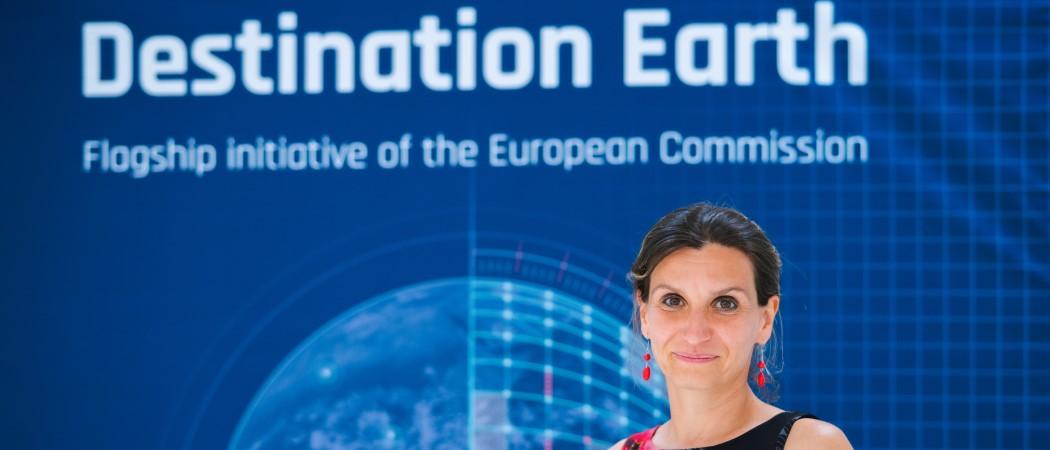From June 2024 the Destination Earth initiative will begin to showcase global km-scale simulations focused on extreme weather events and on how the climate will evolve in the coming decades.

Irina Sandu, Director of Destination Earth
2023 was the hottest year on record, replete with extreme weather events, many of them resulting in economic damage and loss of life. There is an urgent need to enhance prediction capabilities to better respond and adapt to the environmental challenges posed by extreme events and climate change.
That is the promise of the Destination Earth (DestinE) initiative which aims to provide policymakers and others with a glimpse of the future, both days and decades in advance using bespoke numerical earth system capabilities, to allow for better preparation and responses to disasters related to extreme weather events and climate change.
Financed by the European Union in support of its ambitious Green Deal, the DestinE initiative is being implemented by three major European organisations; European Centre for Medium-Range Weather Forecasts (ECMWF), the European Space Agency (ESA), the European Organisation for the Exploitation of Meteorological Satellites (EUMETSAT), under the leadership of the EU’s Directorate-General for Communications Networks, Content and Technology (CNECT).
ECMWF’s main role in the initiative to-date has been the creation of two “digital twins” of the Earth, one focused on simulation of extreme weather events on a time scale of a few days ahead and the other targeting multi-decadal simulations to inform better climate change adaptation.
Using a combination of some of the largest supercomputers in the world, those of the European High Performance Computing Joint Undertaking, real-time observations and cutting-edge earth-system simulations, the digital twins are being built to be interactive and interoperable, while allowing consistently higher resolution than has been possible on a global basis before. ECMWF is also responsible for developing the Digital Twin Engine, the software infrastructure to efficiently run the digital twins on the EuroHPC supercomputers, to handle their data, and exploit the latest breakthroughs in machine learning and artificial intelligence.
Irina Sandu Director of Destination Earth at ECMWF says “DestinE is an initiative built on collaboration. During the first phase, more than 60 organisations from over 20 countries have been involved in ensuring the building blocks were in place for the first two digital twins and the Digital Twin Engine. Phase two, starting in June, is an opportunity to build further on this success, to open the DestinE system to its first users, to continue to incorporate new advances in technology, and demonstrate the benefits that the initiative will bring.”
Digital models for the near-term and the long-term
“In the Climate Change Adaptation digital twin, we are doing a big jump in scales, from a resolution of about 100 km down to 5-10 km,” explains Irina Sandu. “It thus provides consistent information globally and it does so with local granularity, at scales where extreme events and climate change happen and are felt. This digital twin will operationalize the capability to perform multi-decadal projections, allowing to explore how the climate could evolve under different scenarios over the next decades (2020-2050).
The Weather-induced Extremes digital twin will provide global simulations at a resolution of 2-4 km (from 9 km today) and can even zoom in to a few hundred meters over Europe when extreme events emerge, giving policymakers across Europe the chance to better plan for extreme weather events by complementing existing capabilities. DestinE is also integrating artificial intelligence tools into the mix. “It’s motivating to do this for the benefit of society,” Sandu adds.
Demonstration of capabilities planned for 2024
Sandu says the new system will be running simulations on climate change and extreme weather events on a regular basis by June, when the initiative will transition into its second phase, and the partners will demonstrate the potential of the digital twins in several areas.
For example, the Climate Change Adaptation digital twin promises to allow more effective harnessing of renewable energies and to support the design of resilient infrastructure. “If you want to construct a train line from the north to the south of Europe, you’d need to know how cold and warm it would be for the heat and air conditioning and the rails where the train will pass,” Sandu notes. Likewise, a shipping company could be interested in how the winds will change across a certain path so it could use sails to reduce consumption of fossil fuels, and a wind farm could request information on the impact of different scenarios on the wind energy production at certain locations one or two decades ahead.
The next phase in the initiative, which runs through 2026, will focus on ramping up operations and evolving the DestinE system, connecting additional users to the system and continuing to refine it over time.




 A unique international forum for public research organisations and companies to connect their external engagement with strategic interests around their R&D system.
A unique international forum for public research organisations and companies to connect their external engagement with strategic interests around their R&D system.